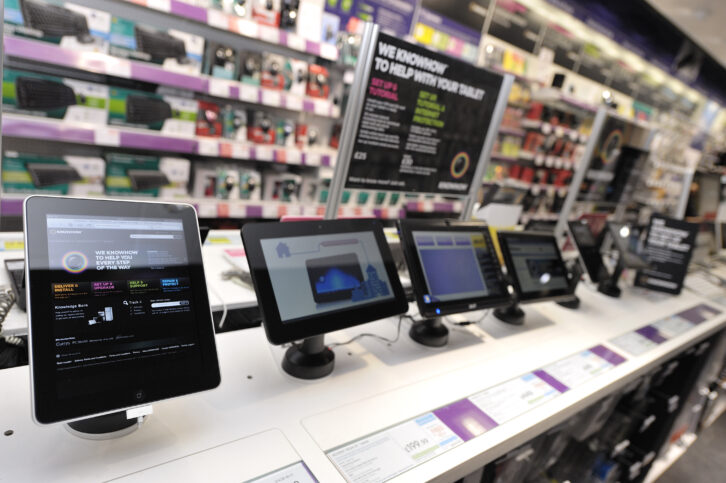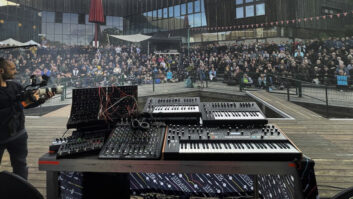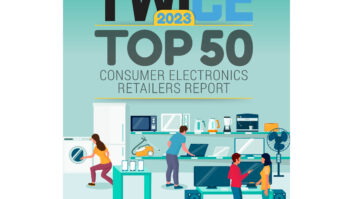
Sales of premier consumer technology products – smartphones, TVs, PCs/tablets, smart home, for instance – continue to dip. High-interest rates, inflation, and recession fears continue to either delay discretionary consumer purchasing or are pushing consumers to “trade down” to lower-priced goods. Many vendors and retailers are still sitting on accumulated inventory and Covid-crippled supply chains haven’t completely healed. Changing staffing and workplace dynamics are challenging operational stability. Even the war in Ukraine has introduced a layer of uncertainty within the industry.
Considering these economic and business pressures, what’s the consensus view of the state of the CE industry from retailers, vendors, and analysts polled by TWICE?
Meh.
“The industry is OK. It’s not great, but it’s not terrible,” encapsulates Bob Cole, CEO and founder of Philadelphia’s World Wide Stereo. “Who sells what and to whom in all areas of the supply chain is in a major state of flux except for maybe the super giants who are trying to control the show. In this environment, it’s very difficult to predict how business will go, and business needs to be predictable. And even the super giants could find themselves having to dance a bit.”
“The state of the industry continues to be fair compared to pre-pandemic results,” believes BrandSource VP Jarred Roy. “Retail is slowing, revenue is mixed, margins are relative, mix has increased, average units per transaction have nearly doubled, and wholesale seems to be mostly recovered.”
“The state of the industry is relatively soft in early 2023 as we deal with a whipsawing overall economy and an exceedingly bumpy post-pandemic period that includes changing consumer spending trends from ‘things’ to ‘experiences’,” echoes Ted Green, president and chief content creator for The Stratecon Group. “All of us in tech are facing a changed and challenging operating environment. With Covid tailwinds subsiding, businesses are having to adjust again.”
“Macroeconomic conditions are creating the biggest challenge for the industry,” cautions Andrew Sivori, head of go-to-market strategy for LG USA Home Entertainment. “While there have been some inflationary puts and takes, continued pressure in food and shelter pricing is poised to start affecting discretionary spending.”
More optimistic observers prefer to see the industry state of the union glass more half full than half empty. “The state of the industry is strong despite some challenges,” insists a cautiously optimistic Rick Kowalski, senior director of business intelligence at CTA, who cites a recent CTA study that reports 84% of U.S. households plan to purchase at least one tech product in the next 12 months.

“As expected, demand for products is lower than it was during the pandemic,” Kowalski admits, “and we will see a small decline in hardware revenue in 2023. The industry is heavily focused on inventory management, adjusting to post-pandemic demand levels while also preparing for the 2023 holiday season.”
“In some respects, the industry has normalized,” contends LG’s Sivori. “The stimulus-fueled ‘sugar high’ of 2021 and the subsequent ‘hangover’ of 2022 have passed, allowing manufacturers to focus on their core missions. The current TV industry trajectory – units are up year-over-year, but dollars have declined as pricing remains deflationary – should continue in the back half of the year, but with anticipated improvement in the trends for the broader holiday timeframe.”
“This year, we are really seeing the industry changing,” notes a slightly sunnier James Fishler, SVP of Samsung America’s Home Entertainment & Display Division, who believes the majority of Covid-related supply chain challenges are in the past. “Turn on any news channel, and you’ll see firsthand the latest reports about fears of a recession and concerns over inflation.
But that isn’t stopping people from making purchases – rather, it’s shifting their perspective, and driving them to look for more quality products with better value. Most purchase intenders report they are looking for premium brands and don’t intend to ‘trade down’ for a lesser product at a better price.”
When’s the Recovery Happening?
Many industry insiders and analysts continue to predict a seemingly perpetually pending recovery. The question, of course, is when will this recovery happen?
“The second half should look better than the first half of 2023,” insists Kowalski, “and considering that Q4 2022 was lackluster in many ways, it is possible that Q4 2023 could outperform last year. This year, we should see a more typical seasonal pattern, with the second half and holiday season generating the bulk of sales.”
“As we look at the industry for the second half, there is an expectation that sales will fare better than we have seen in the first half,” agrees Chad Evans, AVB’s merchandising VP. “I do not believe that anybody is predicting growth, but being close to flat seems to be the goal.”

Not everyone is so sanguine about an H2 recovery, however. “With inflation touching virtually every category, spending on consumer electronics may not be a top priority at present,” argues Sarah Lee, a Parks Associates analyst. “Even ‘essential’ consumer electronics categories are subject to reduced sales performance resulting from the current economic climate. Purchases will pick up eventually, but this will not likely happen until 2024.”
“The second half looks challenging across the board,” concurs Tom Mainelli, IDC’s group vice president for devices and consumer research. “We’ll see normal seasonality across PCs, tablets, and smartphones, which means volumes should be higher than the first half, but overall, it’s going to be tough sledding. We expect commercial device shipments to begin to rebound in 2024, but a consumer rebound is less certain. Lots of new devices were purchased in 2020 and 2021, and now that we’re in a more challenging macro environment, and the end of ‘free’ money in terms of low-interest loans, means companies are postponing additional purchases and consumers are spending their dollars elsewhere.”
But, warns Green, “if a recession occurs…watch out! All bets are off.”
Hot H2 Products?
So what products might fuel a recovery? Renewed consumer interest in VR and AR possibly spurred by Apple’s high-profile Vision Pro, updated gaming consoles, Matter-compatible smart home products, audio products such as in-ear buds and wireless headphones, foldable smartphones, and the still amorphously defined “metaverse” all have been nominated by industry insiders TWICE has spoken with to help lead a holiday and/or 2024 recovery. But…
“We won’t see any of the technologies you mentioned have a big impact in the second half of 2023 as the macro environment isn’t conducive to a big shift,” IDC’s Mainelli insists. “Equally important, none of these technologies are mature enough to make a big impact. The technology poised to have the biggest impact in 2H23 is generative AI, and later this year and early next, we will start to see more hardware begin to ship with silicon that can bring AI-related work from the cloud to the device.”
As in all periods of upheaval, in what shape entities emerge will vary greatly. “We are in a time of chaos, which, depending on a multitude of variables, may get even more chaotic,” Green opines. “The companies that will survive, or even thrive, in this kind of scenario are those which are able to clearly recognize change and effectively adjust their operations to best take advantage of the situation. The number of retail locations are growing steadily as consumers are leaving their homes and preferring to get out into the world to eat out, go to concerts, and to shop at local retail stores. Those stores who offer a better shopping experience are especially benefiting.”
“The power players will learn to surf the chaos,” Green adds. “It will be a wild ride.”
See also: CTA: U.S. Tech Industry Remains Global Leader As Consumer Preferences Change













